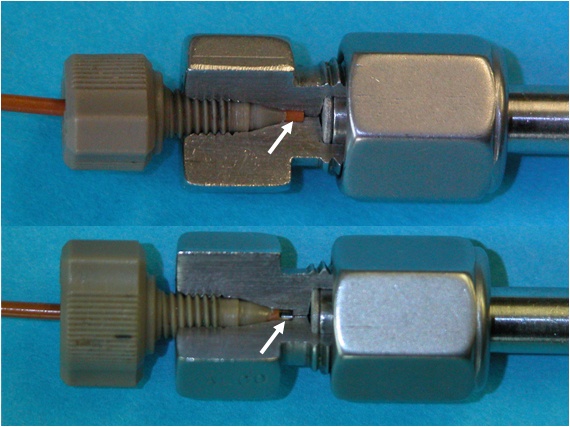PEEK (poly-ether-ether-ketone) fittings and tubing are in widespread use for HPLC applications. The convenience of using your fingers instead of a wrench to tighten the fittings and the flexibility of the tubing make PEEK the material of choice for most HPLC methods when pressures of <400 bar (<6000 psi) are used. PEEK also is used for injection valve rotors in some applications. For the most part, PEEK is problem-free, but there are a couple of cautions that I’d like to point out.
Chemical Compatibility
If you read the fine print for PEEK tubing applications, you’ll see that use with tetrahydrofuran (THF) and the chlorinated solvents is not recommended. Why is this? The tubing doesn’t dissolve, but it becomes brittle and is more likely to burst or snap when exposed to these solvents. The cause has to do with the manufacturing process. PEEK tubing is made by an extrusion process, and some kind of lubricant is required. It is not advisable to add plasticizers, such as might be used with Tygon or some other plastics, because these would leach out rapidly and would likely interfere with the chromatography and/or detection processes. So a small amount of the PEEK monomer is left in the PEEK blend used to make tubing. This monomer provides the necessary lubrication for production and is not dissolved in most reversed-phase HPLC solvents, such as buffers, water, acetonitrile, or methanol.
 Figure 1
Figure 1
However, THF and the chlorinated solvents will leach the monomer from the tubing, gradually changing its physical characteristics. When PEEK tubing was first introduced, our lab did extensive testing to see if we could leach out anything that might cause chromatographic problems or UV interferences. We found nothing of concern in this area, and this is the general experience in the 15 or more years that PEEK tubing has been in use. Even with THF and chlorinated solvents, we did not see any UV absorbing extractables. Since then we’ve found occasional LC-MS problems with extractables from PEEK when THF was used; presumably the monomer, which is innocuous for UV applications, is not so innocent in the MS environment. Don’t use THF and you should be fine. By the way, you don’t need to be concerned about solvent stability with machined PEEK, such as valve rotors – these use a different formulation of PEEK that does not contain residual monomer. For additional information about PEEK tubing, see 'PEEK Tubing – Benefits and Liabilities'.
Pressure Limits
With the advent of finger-tightened fittings that use “wings” on the nuts (as in Figure 1) to give a little extra finger power, PEEK fittings can be used for any of the conventional HPLC applications where pressures are less than 400 bar (6000 psi). However, there are a couple of potential problems that you should be aware of in this regard. If a system over-pressure is encountered, such as when a blockage occurs or another event causes the upper pressure limit to be exceeded, the tubing in the fitting may slip. When a leak occurs at a PEEK fitting, whether it is a connection using PEEK or stainless steel tubing, the tubing may slip when the fitting is tightened if the proper process is not used.
With a little imagination, you can see that the ferrule that grips the PEEK tubing is in some ways similar to the pump seal and piston. If friction is reduced, such as by rotating the ferrule on the tubing, the tubing may slip in the fitting, especially if the pump is operating, so that there is pressure in the system. If you are lucky, the tubing will come completely out of the fitting and the problem will be obvious. More likely, however, is the case shown in the cut-away fitting in Figure 1. In the top assembly, you can see that the brown PEEK tubing (arrow) is seated firmly at the bottom of the fitting port, so the opening in the tubing is aligned with the small passage leading to the column. This is the way the fitting should be assembled. In the lower example, the tubing has been pushed partly out of the fitting leaving a gap at the tip of the tubing (arrow) that results in extra-column volume that can cause band spreading and/or carryover. This can happen if an attempt is made to tighten the fitting when the pump is operating. The volume can be considerable – a 1/16” o.d. (≈1.5 mm) tube, as is shown here, will leave ≈2 µL for each 1 mm of gap created. The solution to this problem is simply to use the following procedure when tightening PEEK fittings:
1. Turn off the pump (or set the flow to 0 mL/min)
2. Loosen the nut
3. Push the tubing firmly into the fitting body
4. Tighten the nut
5. Restart the pump
These simple steps can help you avoid the unpleasant surprises created when small gaps are introduced into tubing connections.
This blog article series is produced in collaboration with John Dolan, best known as one of the world’s foremost HPLC troubleshooting authorities. He is also known for his research with Lloyd Snyder, which resulted in more than 100 technical publications and three books. If you have any questions about this article send them to TechTips@sepscience.com




